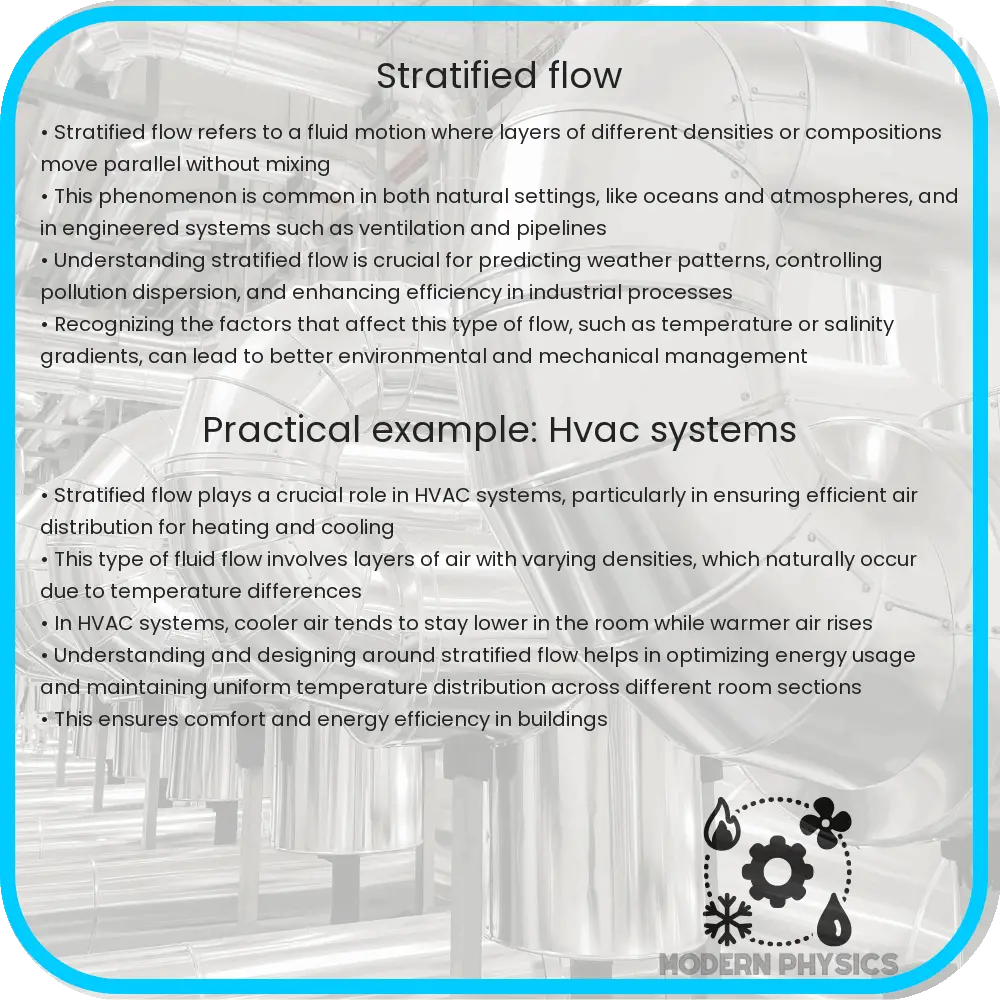Stratified flow is the layering of fluids with varying densities due to temperature or salinity differences, crucial in hydrodynamics and engineering.

Understanding Stratified Flow in Hydrodynamics
Stratified flow refers to the phenomenon where fluids of different densities layer without completely mixing. These flows occur naturally in the environment and are crucial in various engineering applications. In hydrodynamics, understanding the stability and mixing of stratified flows is essential for predicting their behavior and impacts in natural and engineered systems. This article explores the basic principles of stratified flows, their stability, mixing patterns, and practical applications in hydrodynamics.
What is Stratified Flow?
Stratified flows typically involve the layering of fluids that have different densities due to variations in temperature, salinity, or both. For instance, in oceans, saltier, colder water tends to sink below warmer, less salty water, forming distinct layers or strata. Similar stratification can be observed in the atmosphere’s temperature layers. In engineering, stratified flows play a vital role in processes like ventilation, water purification, and chemical engineering.
Stability of Stratified Flows
The stability of stratified flows dictates whether the fluid layers will remain distinct or mix. Stability is assessed using the Richardson number (Ri), a dimensionless quantity defined as:
Ri = (g * Δρ * h) / (ρ * ΔU2)
where g is the acceleration due to gravity, Δρ is the difference in density between the two layers, ρ is the mean density, h is the depth of the upper layer, and ΔU is the difference in velocity between the layers. A Richardson number greater than 0.25 generally indicates stable conditions, where turbulence is suppressed and mixing is minimal.
Mixing in Stratified Flows
Mixing in stratified flows can occur due to various mechanisms such as internal waves, shear instability, or convective overturning. These mechanisms can break the stability of the flow, leading to turbulence and increased mixing. The degree of mixing is crucial in many applications as it affects the transport and dispersion of pollutants, nutrients, and other substances within a stratified medium.
Applications of Stratified Flow
Stratified flows have wide-ranging applications across various fields:
- Environmental Engineering: In lakes and reservoirs, understanding stratified flows can help in designing effective water treatment and distribution systems.
- Oceanography: Stratified flow patterns influence ocean currents, climate models, and marine biology habitats.
- Industrial Processes: In the oil and chemical industries, stratified flows affect the design and operation of pipelines and storage tanks.
- Building Services: Properly managed stratified flows can enhance the efficiency of air conditioning and heating systems.
The study and management of stratified flows mesh physical concepts with practical applications, demonstrating the interplay between basic physics and engineering solutions. This fusion is crucial in devising systems that are both efficient and sustainable, adhering to environmental and industrial standards.
Challenges in Analyzing Stratified Flows
Despite their prevalence and importance, analyzing stratified flows presents several challenges. Accurately predicting and modeling these flows requires sophisticated simulation tools that can handle complex fluid dynamics equations and varying boundary conditions. Furthermore, environmental fluctuations such as temperature changes and dynamic wind patterns can alter the stability and mixing of stratified layers, complicating predictions.
Technological Advancements in Studying Stratified Flows
Advancements in technology have improved our understanding and ability to manage stratified flows. High-resolution sensors and improved computational models allow for more accurate measurements and predictions of fluid behavior. These technologies enable scientists and engineers to visualize and analyze the dynamical properties of stratified fluids in real-time, leading to more effective and adaptable solutions in various applications.
Conclusion
Stratified flow is a fundamental concept in hydrodynamics with significant implications across a wide range of natural and engineered systems. From maintaining aquatic ecosystems to optimizing industrial processes, understanding the dynamics of stratified flows is crucial. The Richardson number helps determine the stability of these flows, which in turn influences their mixing characteristics and the overall system behavior.
Challenges remain in accurately modeling these complex systems, but ongoing technological advancements are continuously improving our ability to predict and manipulate stratified flows. With further research and development, we can enhance our strategies for managing these flows, leading to more sustainable practices and more efficient engineering applications. Ultimately, the mastery of stratified flow not only deepens our understanding of fluid dynamics but also broadens the potential for innovation in tackling environmental and industrial challenges.
